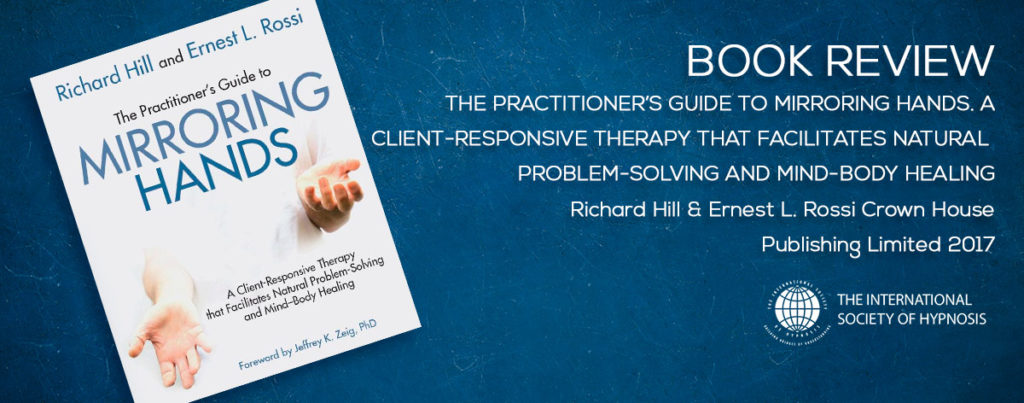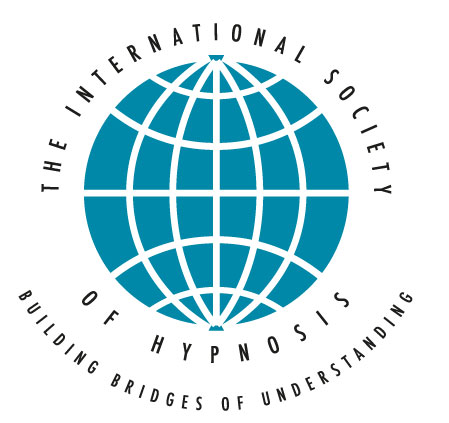

A client – responsive therapy that facilitates natural problem-solving and mind-body healing.
Richard Hill & Ernest L. Rossi Crown House Publishing Limited 2017.
In some way the title of this book covers the content in a nutshell. Mirroring Hands refers to a hypnotic technique, where hands are used as a start of focusing and noticing ideo-sensory changes, as an induction of trance. The method has been studied and elaborated by Rossi and had been published earlier in the Ideodynamic Healing in Hypnosis, with a basic accessing formula and moving hands in accessing creative resources. (Rossi & Cheek, 1988).
The current book is a further development demonstrating more flexibility in the way of asking questions, offering many examples of how and where the method can be integrated in the clinical field with case studies from both Rossi and Hill. For students and clinicians, detailed and concrete guidelines help to integrate the method in their own clinical work. Basic assumptions in the book, are the existence of and trust in the inner wisdom of the unconscious, an Ericksonian delicate and respectful way to access the unconscious, ratified and made explicit by the hand movements. Prior to the therapeutic work clients get familiar with the induction to therapeutic consciousness (chapter 3) and therapists learn to adapt language principles and to improve client responsiveness (chapter 4). Three easy to follow steps introduce a therapeutic consciousness: Focused Attention, introducing curiosity with awareness of energy sensation, contrasting sensation and conceptual sensation, to end this introductory process with validating nascent confidence. A basic accessing question is based on Erickson’s implied directive: a time-binding introduction, the implied or assumed suggestion, a behavioural response that signals when the implied suggestion has been accomplished. In 1980, Rossi made a simple change to create a curiosity question: (1) As soon as you know (2) you are able to begin working with your inner thoughts (3) will your hand descend to your thigh? (p. 63).
The Four-Stage Creative Cycle is a universal pattern: from stage 1, where we Gather Information – what is this all about? – you guide the client to an inner mind-body experience, stage 2, Incubation – how does this affect me? What does this mean to me? And trusting inner resources, giving the process the necessary time, clients can reach stage 3, Breakthrough and illumination – insight, resolution, revelation – “I can create something better in my life”! In stage 4, or Verification – I understand, appreciate, and accept what I have learned, a bridge can be made between the experience, and integrating this into one’s own life challenges or issues one has to deal with.
One of the polarities is the winner-loser contrast to curiosity in chapter 9 on “Curiosity and the Elephant in the Room.” In different examples the conversion of a problem into a resource and how the hands follow the process, making the process visible in ideo-motor responses to optimize the pacing process of the interaction is illustrated. Chapter 10, on clearing out the negative, preparing for the positive is a very powerful technique in clinical practice, helping to resolve old pain, negative experiences and really “closing the door”, in a way the negativity can’t pop up at random.
In line with Ericksonian hypnosis principles and trusting inner resources or healing processes “problem solving through self-organization occurs within the implicit inner space as a natural function of an adaptive complex system” (p. 110). Isn’t it wonderful to discover that “Mirroring hands” method is able to open that connection and resolve issues without the client having to consciously relive painful experiences. What clients learn, can be an excellent start to continue the experience as a self-help tool. This is explicitly explained in chapter 13 “Personal access to your growing edge” or the solo and personal use of mirroring hands. And as experiences are not restricted to the mind, as clients notice ideo-sensory changes, from a scientific viewpoint, one wants to see proof of it and to measure the changes!
The last chapters guide the seriously curious “down the rabbit hole” to the quantum and the Yet-To-BeKnown, leaving the classical world or macro world, to the quantum world and qualia, where rules are different, and surprising quantum phenomena as“entanglement”, where “two particles are in corelationship, regardless of the distance between them” are seen. (p. 223).
Quantum field theory research on “how the quantum qualia, of the human observer-operator during subjective experience can be a causal agent in facilitating health and problem-solving on the objective molecular/genomic level” is a very exciting field of research. Future research in understanding / explaining how the four stage models affects mindbody processes, with the most advanced technical equipment will be needed! Who is ready to take the challenge?
The structure of the book, with some background knowledge, step-by-step outline for practices, clinical examples and a summary at the end, makes it an excellent book useful in teaching for students and a handbook for clinicians to enrich their clinical practice. The current and new hypothesis will stimulate reflections to understanding deeper processes at the basis of therapeutic change.
